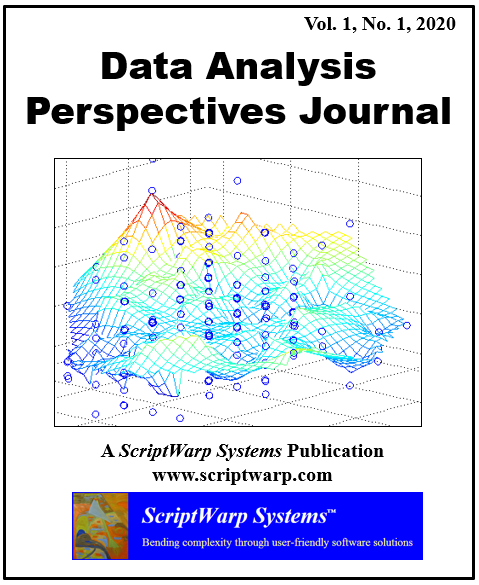

[Editor] [Contact] [Mission] [Review process] [Published articles]
Texas A&M International University, USA
Editorial Assistant
The main goal of the Data Analysis Perspectives Journal (DAPJ) is to publish, every year, a small number of carefully selected short articles that can guide and inform users of data analysis tools and techniques developed by ScriptWarp Systems. The selection of topics for articles is done based on requests and feedback from users.
DAPJ is modeled after existing tool-specific journals. As is common with these types of journals, it is expected that the articles published in DAPJ will be direct, succint, and aimed at helping users with minimal academic "pageantry".
The review process includes two main stages: (1) first papers are invited, based on information received from users and from experts; and (2) the invited papers undergo a review process, whereby typically two of more reviews produced by experts are compiled for each paper. After a first round of reviews a paper may be accepted, invited for a revised resubmission, or rejected.
Only invited papers are placed under review.
Invitations are usually extended to recognized experts, or individuals mentored by those experts. A key indication of expertise, although not the only one used, would be prior publication in one or more highly selective refereed journals, regardless of field of study. Here the focus is particularly on prior publication of empirical research using the data analysis tools and techniques that are the target of an invitation.
Cox, J. (2024). Combining sub-samples for improved statistical power in PLS-SEM: A constrained latent growth approach. Data Analysis Perspectives Journal, 5(1), 1-5.
Kock, N. (2023). Using logistic regression in PLS-SEM: Dichotomous endogenous variables. Data Analysis Perspectives Journal, 4(4), 1-6.
Kock, N. (2023). Assessing multiple reciprocal relationships in PLS-SEM. Data Analysis Perspectives Journal, 4(3), 1-8.
Amora, J. T. (2023). On the validity assessment of formative measurement models in PLS-SEM. Data Analysis Perspectives Journal, 4(2), 1-7.
Ma, K. Q., & Zhang, W. (2023). Assessing univariate and multivariate normality in PLS-SEM. Data Analysis Perspectives Journal, 4(1), 1-7.
Kock, N. (2022). Using causality assessment indices in PLS-SEM. Data Analysis Perspectives Journal, 3(5), 1-6.
Ezeugwa, B., Talukder, M. F., Amin, M. R., Hossain, S. I., & Arslan, F. (2022). Minimum sample size estimation in SEM: Contrasting results for models using composites and factors. Data Analysis Perspectives Journal, 3(4), 1-7.
Kock, N. (2022). Testing and controlling for endogeneity in PLS-SEM with stochastic instrumental variables. Data Analysis Perspectives Journal, 3(3), 1-6.
Rasoolimanesh, S. M. (2022). Discriminant validity assessment in PLS-SEM: A comprehensive composite-based approach. Data Analysis Perspectives Journal, 3(2), 1-8.
Canatay, A., Emegwa, T., Lybolt, L. M., & Loch, K. D. (2022). Reliability assessment in SEM models with composites and factors: A modern perspective. Data Analysis Perspectives Journal, 3(1), 1-6.
Kock, N. (2021). Common structural variation reduction in PLS-SEM: Replacement analytic composites and the one fourth rule. Data Analysis Perspectives Journal, 2(5), 1-6.
Hubona, G., & Belkhamza, Z. (2021). Testing a moderated mediation in PLS-SEM: A full latent growth approach. Data Analysis Perspectives Journal, 2(4), 1-5.
Amora, J. T. (2021). Convergent validity assessment in PLS-SEM: A loadings-driven approach. Data Analysis Perspectives Journal, 2(3), 1-6.
Kock, N. (2021). Harmanís single factor test in PLS-SEM: Checking for common method bias. Data Analysis Perspectives Journal, 2(2), 1-6.
Morrow, D. L., & Conger, S. (2021). Assessing reciprocal relationships in PLS-SEM: An illustration based on a job crafting study. Data Analysis Perspectives Journal, 2(1), 1-5.
Kock, N. (2020). Using indicator correlation fit indices in PLS-SEM: Selecting the algorithm with the best fit. Data Analysis Perspectives Journal, 1(4), 1-4.
Moqbel, M., Guduru, R., & Harun, A. (2020). Testing mediation via indirect effects in PLS-SEM: A social networking site illustration. Data Analysis Perspectives Journal, 1(3), 1-6.
Kock, N. (2020). Multilevel analyses in PLS-SEM: An anchor-factorial with variation diffusion approach. Data Analysis Perspectives Journal, 1(2), 1-6.
Kock, N. (2020). Full latent growth and its use in PLS-SEM: Testing moderating relationships. Data Analysis Perspectives Journal, 1(1), 1-5.